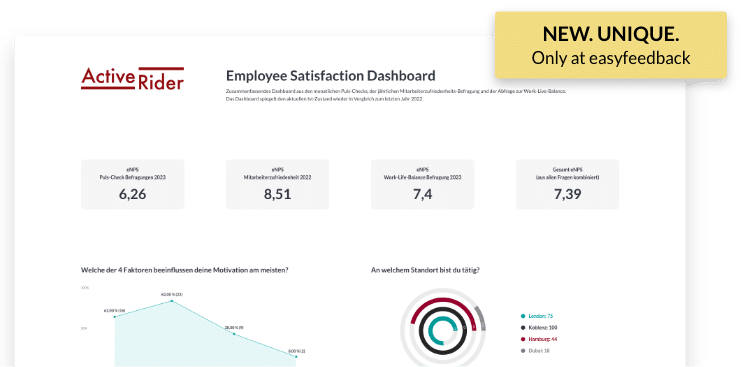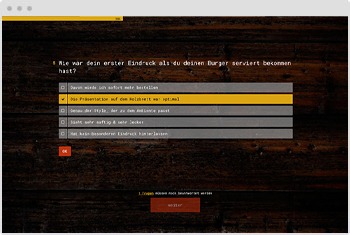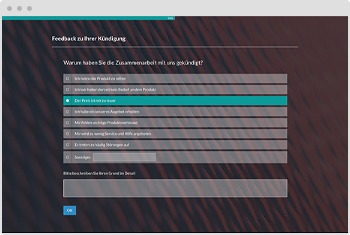Optimize service & support quality through customer feedback

This ready-to-use survey template will help you create a long-term bond with your customer. Because after purchase, support is your biggest interface with the customer.

“Identifying customer needs is an essential part of our business. easyfeedback accompanies us for many years as a loyal partner in this task. We particularly appreciate the intuitive usability of the survey tool as well as the professional support.”
Guild Lead User Experience Research

“We use easyfeedback for internal and external surveys – fast, comfortable and really easy! Straightforward and cordial support can always create a smile. We really appreciate the permanent development of the platform.”
Guest & Competitor Insights Analyst
Content and targets of this support feedback template
Every contact with support is a user experience for the customer. What is your customer’s experience? Find out how good your support is, whether there is room for improvement, and get customer feedback on service quality.
A satisfied customer is most likely to remain your customer. Resolving problems creates the user experience that customers remember. Survey your customers about your support experience and identify strengths and weaknesses. Provide solutions that your customers really want.
So a questionnaire about the quality of your support can help you optimize the customer experience in the long run.
Content:
• How fast is my support
• Identifying weaknesses and strengths
• Making problems visible and solving them
• Uncovering customer requirements
• General feedback on support
Targets:
• Increase customer satisfaction
• Identify churn risks
• Find opportunities for improvement
• Increase service quality
• Improve the website user experience
• Strengthen customer loyalty

Data privacy protection „made in Germany“ (GDPR)

Anonymity functions for open feedback
Almost everything you need to know about customer service & support
1. What is customer service?
Customer service is concerned with advising and supporting people who are interested in or have already purchased the products or services offered.
Customer service is an organizational area within a company and can be subdivided into various sub-tasks, such as technical support, sales promotion and customer advice, customer retention, and complaint and reclamation management.
The quality and competence of customer service can be a decisive factor here in why prospects become customers and customers become existing customers.
2. What is customer support?
The terms customer service and customer support are often used interchangeably. Customer support refers to technical support for customers, for example, in troubleshooting or training for software, while the term customer service is somewhat broader. Customer support is thus a subarea of customer service.
3. What are the goals of customer service?
Customer service provides support as a point of contact for questions and problems of all kinds. However, this not only has advantages for the customer, but also serves to gain the trust of prospective customers and strengthen customer loyalty. The aim is to promote sales as a result.
By talking to customers and listening to their questions and problems, it is also possible to draw conclusions about possible weak points in the products. The collected data can then be used to develop and improve products.
4. How are the competences of the technical support subdivided?
Technical support is divided into levels, which we have listed and explained to you below:
First-Level Support
This is the first point of contact for customers and interested parties. Here will be dealt with technical questions and problems, which are mostly known and can be solved quickly.
Furthermore, first-level employees are responsible for problem identification and classification. If problems cannot be solved directly, the case will be passed on to a specialist of the second-level support.
Second-level support
If technical questions or problems cannot be dealt with by the first level, the second level employees come into play. They deal with the existing problem and communicate the solution directly to the customer. In many companies, the 2nd-level support is the highest level of support.
Third-level support
Depending on the size of the company, there may also be a third-level support, which deals more intensively with unknown or previously unresolved problems if the 2nd-level support was unable to solve them. This is the highest level of the support model.
5. How can you measure your own customer service?
There are various metrics that make it possible to measure customer satisfaction with customer service and its performance.
Customer service is an important touchpoint in the customer lifecycle and can therefore be an important factor in whether prospects become customers and customers become existing customers.
Below, we have explained five metrics in more detail:
Customer Satisfaction Score (CSAT)
In a survey, customers rate their experience with certain services provided by a company on a predefined scale, usually from very dissatisfied (1) to very satisfied (5). An example question for measuring satisfaction with support would be, “How would you rate the response time of our support?”
At the end of the survey, if you calculate the number of very good and good ratings by the number of all ratings and multiply that with 100, you get the customer satisfaction percentage.
This key figure helps to identify the current customer experience with customer service or support and, if necessary, to derive measures for optimization.
Net Promotor Score (NPS)
In contrast to the CSAT, the NPS is about asking for willingness to recommend. This method of researching satisfaction requires only one question and is asked on a scale of 0 – 10. An example question, related to the evaluation of customer support, could be as follows: “Would you recommend our customer support to others?”.
You can easily ask this question using a survey tool such as easyfeedback, for example. In this way, you can quickly determine the extent to which a customer support meets customer expectations and requirements.
The Net Promotor Score is calculated as follows:
Number of people who indicated the value 9-10 (in %), divided by the number of people who indicated the value 0-6 (in %), results in the NPS (value between -100 % and +100 %). The higher the value, the more positive the result.
Customer Effort Score (CES)
This key figure is also known as the customer effort index and measures how quickly and easily a customer’s problem or inquiry could be solved, taking into account in particular the customer’s effort aspect.
The survey always relates to one issue and should be conducted directly afterwards. An example question could be, “What effort did you have to expend to report your problem to our support?” The customer can then choose, for example, on a scale from very little effort (1) to very high effort (5).
This measurement can also be carried out via a questionnaire using a survey tool such as easyfeedback.
First Response Time
This is a metric that measures time. In our example, from the first example the customer contacts us via email, form, chatbot or otherwise, till the first response from a customer support. In other words, the customer service response time is determined. Qualitative aspects are disregarded in this method.
Customer retention rate
The customer retention rate is used to determine the extent to which the company was able to retain customers over a specific period of time. The period can be defined as required, for example, a week, a month or a year.
The customer retention rate is calculated as a percentage. The number of customers at the end of the assessment period minus the number of new customers during the assessment period is divided by the number of customers at the beginning of the assessment period and multiplied by 100. The higher the value at 100, the higher the company’s retention rate.
6. What belongs to a good customer service?
Good customer service can be defined differently here and there. Therefore, we share with you what constitutes good customer service for us:
1. Offer multiple communication channels
Offer your customers several different channels to get in touch with your customer service. Possible channels include phone, email, chat bots, community forum, or offering support via social media.
2. Acknowledge receipt of the request
Send a short acknowledgement of receipt stating that the request has been received and will be processed as soon as possible. This lets the customer or prospect know that their request is being taken care of.
3. Short response time
A support or customer service representative who responds quickly to inquiries already contributes to a higher level of satisfaction among the inquiring person, regardless of their response.
There is nothing more annoying than waiting for an urgent answer to your question. And if the question is answered in a solution-oriented and competent manner, this is an additional bonus for the image of your company.
4. Be friendly and patient
When problems arise, customers’ nerves can get the better of them. However, it is not good if you react the same way. Bring patience and work with the customer. Listen and try to be supportive.
5. Score with honesty instead of cluelessness
If you don’t have an immediate solution, let the customer know and point out that you need some time to get to deal with the issue. The customer usually understands this, since an incorrect answer based on ignorance will not help him.
6. Competence
Furthermore, it makes sense to train employees in customer service both professionally and personally. Lack of knowledge or incompetent problem solving lead to customer dissatisfaction. But an unfriendly consultant can also have a negative impact on customer satisfaction.
7. How can easyfeedback help me optimize customer service and support?
Surveys with easyfeedback offer you the opportunity to measure your customers’ satisfaction with support and customer service and to continuously optimize them.
Ask about the quality of support, the communication channels offered, or the willingness to recommend your company to others. Learn about the needs and expectations of your customers and prospects and meet them with excellent customer service.
To shorten waiting times, for example, you can make additional communication channels available or provide targeted training for employees. Good customer service is an important and co-decisive factor in the success of your company.
You are in professional company






easyfeedback welcomes more than 740.000 participants per month!







